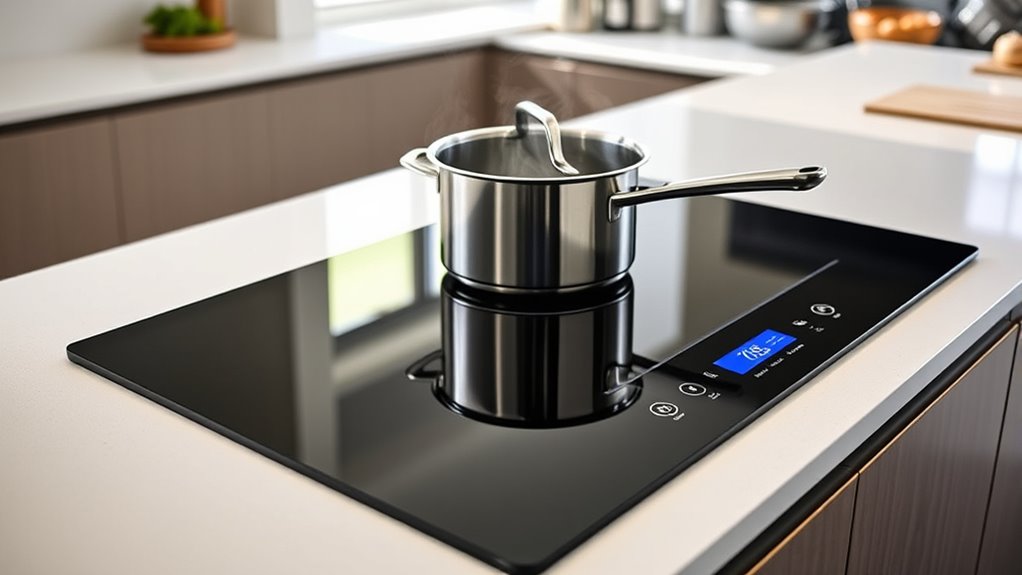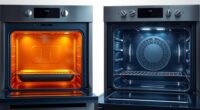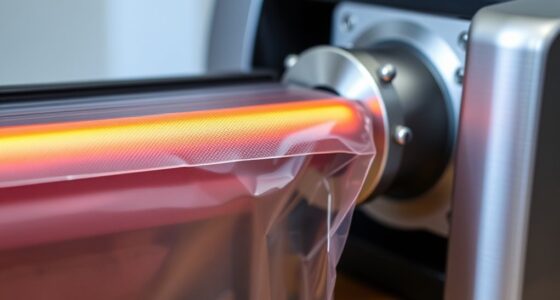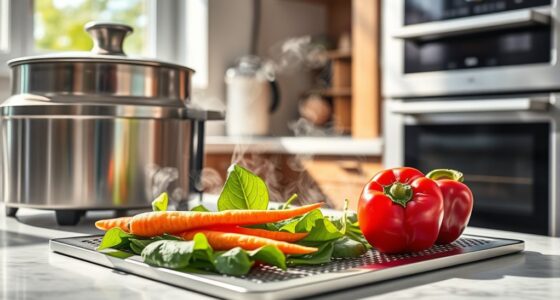Induction cooking heats your pots and pans directly using electromagnetic fields, making it faster, safer, and more efficient than traditional stoves. It minimizes heat loss, keeps the cooktop cool, and provides precise temperature control, which saves energy and time. Plus, it’s safer with automatic shut-offs and cool surfaces. If you want to discover how these features work together to improve your cooking experience, there’s more to explore below.
Key Takeaways
- Induction cooking uses electromagnetic fields to directly heat cookware, providing faster and more efficient heat transfer.
- It offers precise temperature control and quick response times, enhancing cooking accuracy.
- The cooktop remains cool to the touch, reducing burn risks and improving kitchen safety.
- Energy efficiency minimizes heat loss, lowering utility bills and environmental impact.
- Operational controls like touch panels make cooking safer, more convenient, and easier to manage.

Have you ever wondered why induction cooking is gaining popularity in modern kitchens? The answer lies in its impressive combination of energy efficiency and safety features that make it stand out from traditional cooking methods. Unlike gas or electric stoves, induction cooktops use electromagnetic fields to directly heat pots and pans, which means less energy is wasted, and you get faster, more precise cooking. This energy efficiency not only saves you money on utility bills but also reduces your carbon footprint, making it an environmentally friendly choice for your home.
One of the key reasons induction cooking is so efficient is that it transfers heat directly to the cookware, rather than heating the cooktop surface first. This targeted heating process means less energy is lost to the surroundings, allowing your food to cook faster and more evenly. Plus, since the cooktop itself stays relatively cool, you spend less time waiting for it to heat up or cool down, which further conserves energy. This direct transfer of heat also translates into quicker response times when adjusting temperature settings, giving you greater control over your cooking process.
Safety features are another major advantage that draws people to induction cooking. Because the cooktop surface remains cool to the touch, you reduce the risk of burns or accidental fires—especially important if you have children or pets around the kitchen. Additionally, induction stoves only heat when a compatible ferromagnetic pan is placed on them, which means accidental activation or leaving the stove on becomes less likely. Many models also come equipped with automatic shut-off features, which turn the heat off if no cookware is detected or if the pan boils dry, adding an extra layer of safety.
Furthermore, induction cooktops often include controls like touch-sensitive panels and precise temperature settings, making them easier and safer to operate compared to traditional stoves. The absence of open flames or hot coils eliminates many common hazards associated with gas and electric stoves. This creates a safer kitchen environment overall, especially if you’re busy or distracted while cooking. Understanding bank swift codes can also help ensure secure financial transactions when purchasing new appliances.
Frequently Asked Questions
Is Induction Cooking Safe for Children and Pets?
Induction cooking is generally safe for children and pets because the cooktop surface remains cool, reducing burn risks. You should still practice child safety by keeping children away from hot areas and never leaving pets unattended near the stove. Since induction heats cookware directly, there’s less risk of accidental fires or burns, making it a safer choice for households with kids and pets. Always supervise and use safety features to ensure everyone stays safe.
Can Induction Cooktops Be Used With All Types of Cookware?
Think of induction cooktops as selective partners, only compatible with cookware that has strong magnetic properties. If your pots and pans are made of ferrous materials like cast iron or stainless steel, they’ll work perfectly. Non-magnetic cookware, such as aluminum or copper, won’t heat up on induction surfaces. So, check for compatibility by testing with a magnet—if it sticks, you’re good to go.
How Energy-Efficient Is Induction Cooking Compared to Traditional Methods?
Induction cooking is highly energy-efficient, saving you money on energy bills by converting more electricity directly into heat with minimal waste. You’ll notice faster cooking times and less heat loss, which also reduces environmental impact. Compared to traditional methods, induction uses less energy overall, making it an eco-friendly choice. This means you get efficient performance while contributing to energy savings and a smaller carbon footprint.
Are There Any Health Concerns Associated With Induction Cooking?
You might wonder about the health impact of induction cooking, but rest assured, it’s generally safe. While electromagnetic fields are involved, they’re well within safety limits set by health authorities. Modern induction stoves are designed to minimize any exposure, making them a convenient and safe choice. If you have pacemakers or other electronic devices, it’s wise to consult your doctor, but for most, induction cooking poses no significant health concerns.
What Maintenance Is Required for Induction Cooktops?
You should clean your induction cooktop regularly with a soft, damp cloth to prevent buildup and maintain surface durability. Avoid abrasive cleaners or scrubbing pads, as they can scratch the surface. Wipe spills immediately to prevent staining and guarantee peak performance. Routine cleaning keeps your cooktop looking new and functioning efficiently, while gentle maintenance helps preserve its durability over time. Keep these routines consistent for the best results.
Conclusion
Now that you know how induction cooking heats so efficiently and safely, it’s easy to see why it’s a game-changer. While traditional stoves rely on slower, less precise methods, induction offers rapid results and energy savings. Imagine cooking in a flash while saving money and space—truly a modern upgrade. Embrace induction’s innovation, and you’ll enjoy a faster, safer kitchen experience that outshines old-fashioned methods every time.










